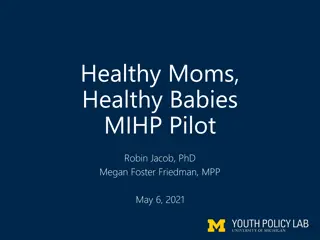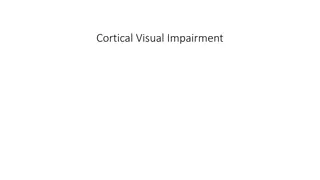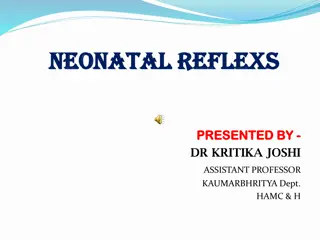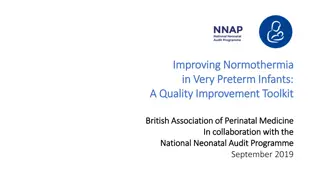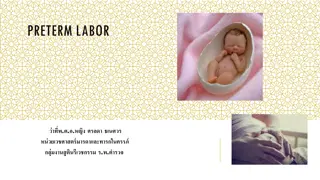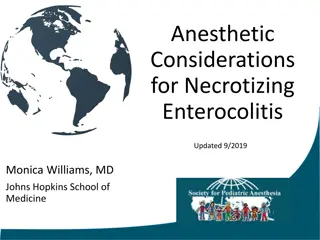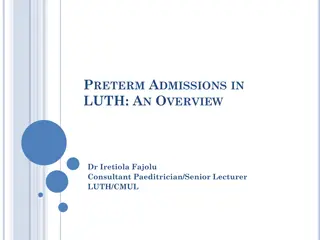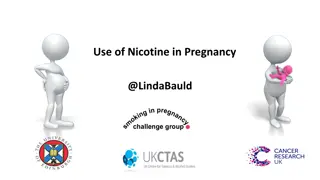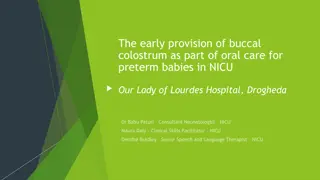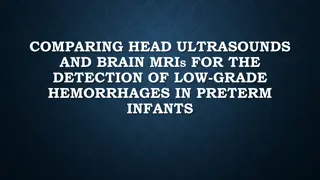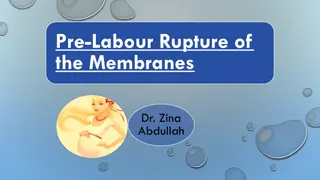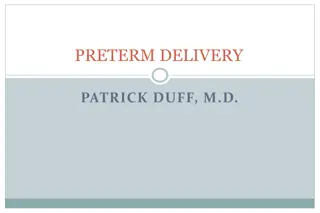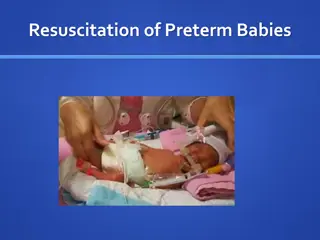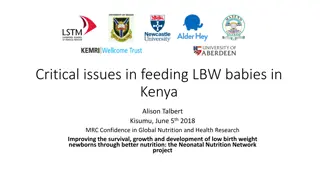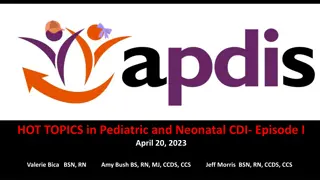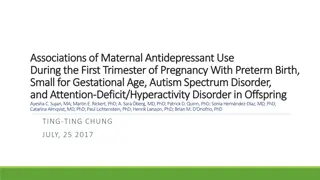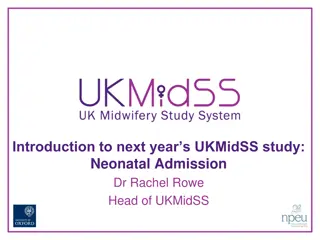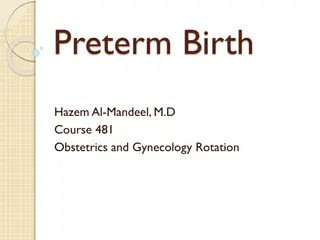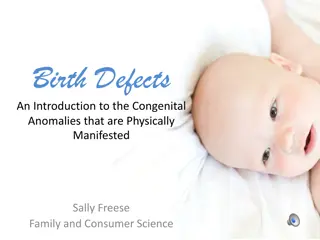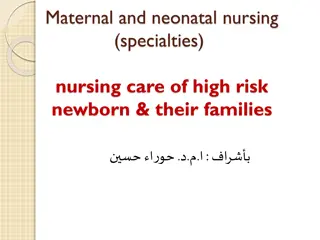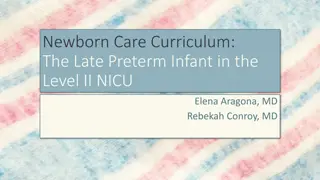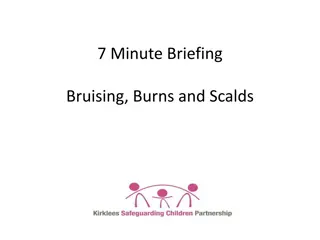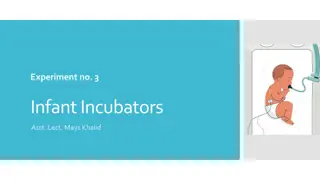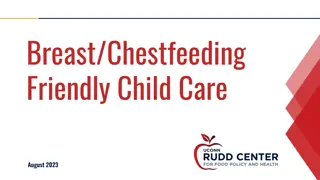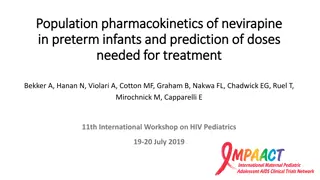Metabolic bone disease
Understand the metabolism of calcium and phosphorus, common disturbances, and nutrient requirements in preterm infants. Learn why metabolic bone disease is important and its long-term effects on bone health.
1 views • 59 slides
Designer Babies
This content provides insights into the ethical considerations surrounding designer babies, exploring key questions, stakeholders, options, and potential impacts on traits like gender, appearance, and intelligence. It delves into genetic engineering methods, pros, and cons of modifying babies, empha
0 views • 28 slides
Protecting Pregnant Women and Babies: Winter Vaccination Campaign 2023
As part of the HSE's Autumn-Winter Vaccinations campaign, the NIO has designed a partner pack promoting flu, COVID-19, and whooping cough vaccines for pregnant women. The campaign emphasizes the importance of getting vaccinated during pregnancy to safeguard both the mother and baby from serious illn
1 views • 10 slides
Early Intervention Approaches and Research Findings
Explore various approaches and techniques for early intervention, focusing on settings, delivery models, stimulation methods, and caregiver involvement. Discover recent studies on infants born during the pandemic and preterm children's outcomes, emphasizing the importance of language, motor, and cog
1 views • 67 slides
(❤Read⚡) [✔PDF✔] Noodles for Baby
\"COPY LINK HERE: http:\/\/isbooktoday.com\/1933067403 |5 minutes ago - \n [PDF READ ONLINE] Noodles for Baby | Your littlest one will love learning about all the different types of noodles Hawaii has to offer a baby's big appetite: yakisoba, pancit, ramen, pad thai, chow fun, fettucine, and mo
0 views • 6 slides
Exploring the Future of Medicine: Genetics, Innovations, and Debates
Delve into a captivating journey through the realms of genetics, medical innovations, and thought-provoking debates surrounding designer babies. Discover the evolution of healthcare, from insulin pumps to genetic design, and ponder the ethical implications of shaping offspring through genetic engine
0 views • 13 slides
Enhancing Maternal and Infant Health: Healthy Moms, Healthy Babies MIHP Pilot Evaluation
Evaluation of the Healthy Moms, Healthy Babies MIHP pilot program focusing on providing additional resources to serve families in need by addressing social determinants of health. The program aims to support high-risk maternal and infant beneficiaries through enhanced services and activities, with p
0 views • 8 slides
Understanding Cortical Visual Impairment in Infants
Cortical Visual Impairment (CVI) is a condition resulting from retrogeniculate brain damage that affects visual processing in infants. Commonly observed in premature infants, CVI can manifest as atypical behaviors like staring at lights, optic atrophy, and nystagmus. The causes range from structural
2 views • 23 slides
Understanding Neonatal Reflexes in Newborn Babies
Newborn babies exhibit a range of primitive reflexes, including the Moro reflex, Glabellar Tap, Rooting and Sucking reflex, Tonic Neck reflex, Palmar and Plantar grasp reflexes. These reflexes serve as indicators for neurological development and function. Observing the presence and characteristics o
0 views • 13 slides
Quality Improvement Toolkit for Improving Normothermia in Very Preterm Infants
This resource provides a comprehensive toolkit developed by the British Association of Perinatal Medicine in collaboration with the National Neonatal Audit Programme to assist clinicians in neonatal units in delivering normothermia to very preterm infants. It includes evidence-based interventions, d
1 views • 17 slides
Understanding Preterm Labor and Its Impact on Infant Health
Preterm labor, defined as the delivery of an infant before 37 weeks of gestation, presents risks such as incomplete organ system development and increased infant mortality rates. Unnecessary obstetrical interventions before 38-39 weeks should be avoided. The trends in preterm birth rates reveal disp
0 views • 68 slides
Anesthetic Considerations for Necrotizing Enterocolitis in Neonates
Necrotizing enterocolitis (NEC) is a serious gastrointestinal emergency in neonates, especially those with very low birth weight. Mortality rates are high, and early diagnosis is crucial. Key features, pathophysiology, implications for anesthetic preparation, and diagnostic considerations are discus
3 views • 20 slides
Neonatal Care at Lagos University Teaching Hospital (LUTH)
Lagos University Teaching Hospital (LUTH) is a tertiary referral center providing comprehensive neonatal care services. The facility has specialized units for inborn and outborn babies, offering advanced medical care, including neonatologists, resident doctors, nurses, and support staff. LUTH also h
0 views • 15 slides
Impact of Nicotine Use in Pregnancy: Risks and Consequences
Smoking and nicotine use during pregnancy pose significant risks, including low birth weight, stillbirth, miscarriage, preterm birth, heart defects, and Sudden Infant Death Syndrome. Nicotine Replacement Therapy is licensed for pregnant women but lacks evidence of effectiveness in smoking cessation
1 views • 23 slides
Improving Buccal Colostrum Provision for Preterm Babies in NICU
Early administration of buccal colostrum to preterm babies in the NICU has shown positive outcomes such as improved gut development, reduced infection rates, and enhanced breastfeeding rates. A Quality Improvement program at Our Lady of Lourdes Hospital aimed to provide buccal colostrum within 6 hou
1 views • 5 slides
Detection of Low-Grade Hemorrhages in Preterm Infants: Ultrasounds vs. MRIs
This study compares the effectiveness of head ultrasounds and brain MRIs in detecting low-grade hemorrhages in preterm infants. It discusses the incidence of intraventricular hemorrhage (IVH) in very low birth weight infants, classification of IVH, risk factors for IVH, outcomes related to IVH grade
9 views • 33 slides
Clinical Diagnosis and Assessment of Pre-Labour Rupture of the Membranes
Pre-Labour Rupture of the Membranes (RROM) is characterized by the leakage of amniotic fluid before the onset of labor, particularly when the gestational age is less than 37 weeks. Clinical diagnosis involves a thorough history evaluation and examination, including sterile speculum examination to co
0 views • 18 slides
Understanding Preterm Delivery: Causes, Complications, and Evaluation
Preterm delivery, defined as labor prior to 37 weeks of gestation, affects approximately 12% of pregnancies worldwide, with almost 30% of these deliveries occurring before 34 weeks. The etiology of preterm birth can vary from maternal factors such as PROM to fetal anomalies and multiple gestations.
0 views • 25 slides
Understanding Cesarean Section and Preterm Labor Risks
Cesarean section (C/S) is a delivery method for various fetal and maternal indications, while preterm labor poses risks like twin pregnancy, uterine abnormalities, and infections. Complications of C-sections and signs of preterm labor are discussed, highlighting the importance of early recognition a
0 views • 9 slides
Understanding Maternal Mental Health Complications
Maternal mental health complications, including postpartum depression and psychosis, can have a significant impact on both the mother and child's well-being. Factors such as stigma, culture, trauma, and lack of support systems can exacerbate these conditions. Early detection and intervention are cru
0 views • 12 slides
Safe Sleeping Practices for Babies: Reduce the Risk of SIDS
Placing babies on their backs to sleep, avoiding co-sleeping, refraining from sleeping with a baby on a sofa or armchair, ensuring a smoke-free environment, and maintaining proper room temperature are crucial for safe sleeping practices to reduce the risk of Sudden Infant Death Syndrome (SIDS).
0 views • 11 slides
Understanding and Supporting Premature Babies: Resuscitation and Care
Premature babies are at higher risk of complications due to their physiological vulnerabilities. They require specialized care to maintain body temperature, assist ventilation, manage oxygen levels, and minimize the chances of lung and brain injuries. Learn why preemies face increased risks and disc
0 views • 12 slides
Overview of Induction of Labour for Obstetric Practice
Induction of labor is the artificial initiation of the labor process before it begins naturally. This procedure is performed in cases such as premature rupture of membranes, prolonged pregnancy, preterm premature rupture of membranes, pre-eclampsia, and maternal medical conditions like diabetes or c
1 views • 30 slides
Guide to Planning Balanced Diets for All Age Groups
Learn about the importance of balanced diets, nutritional needs for different age groups, and how to plan balanced menus using the food pyramid. Discover tips for weaning babies onto solid foods, including the introduction of iron-rich cereals and vitamin C sources. Ensure babies' diets are free fro
0 views • 39 slides
Challenges in Feeding Low Birth Weight Babies in Kenya
Addressing critical issues in feeding low birth weight babies in Kenya, including the lack of accurate birth weight measurements, preterm birth rates, and the risks associated with formula milk feeding. Strategies such as promoting expressed breastmilk and supporting mothers in neonatal units are di
2 views • 15 slides
Challenges Faced by Babies in the Early Neonatal Period When Mother Had PPH
Babies face unique challenges in the early neonatal period when their mothers experience PPH. The outcomes vary based on whether the mother survives or not, affecting factors like delayed cord clamping, skin-to-skin contact, breastfeeding, and maternal care. Premature birth, birth asphyxia, and norm
0 views • 7 slides
Understanding Kangaroo Care for Babies: Benefits and Procedure
Kangaroo care is a method involving skin-to-skin contact where a baby is placed on a parent's bare chest. Developed in the late 1970s in response to high death rates in premature babies, this practice has numerous benefits for both babies and parents. It helps stabilize heart rate, improve breathing
0 views • 20 slides
Understanding the Coding Guidelines for Preterm Newborns with Small for Gestational Age (SGA)
Explore the guidelines for coding preterm newborns who are small for gestational age, including birth weight considerations and criteria for assigning appropriate ICD-10 codes. Gain insights into differentiating SGA from low birth weight and effectively documenting neonatal cases.
0 views • 17 slides
Associations of Maternal Antidepressant Use During Pregnancy with Offspring Outcomes
Prenatal antidepressant exposure during the first trimester of pregnancy is linked to various adverse outcomes in offspring, including preterm birth, small for gestational age, autism spectrum disorder, and attention-deficit/hyperactivity disorder. This study evaluates the associations and alternati
0 views • 28 slides
Efficient Baby Screening and Referral Process Overview
Detailed overview of the screening process from sample collection to clinician consultation, including timelines, referral pathways, and confirmation procedures for preterm babies. Lab turnaround times, repeat sample guidelines, and referral process details are also covered.
0 views • 19 slides
Neonatal Admission Study: Understanding Risk Factors in Midwifery Settings
Neonatal Admission Study led by Dr. Rachel Rowe aims to investigate the admission of babies to neonatal care following birth in midwifery units. The study focuses on identifying risk factors and potential improvements in outcomes. The case-control study involves monthly data collection for 12 months
0 views • 10 slides
Understanding Preterm Birth: Causes, Diagnosis, and Management
Preterm birth, occurring before 37 weeks of gestation, is a significant concern in obstetrics due to its association with perinatal mortality and morbidity. This article delves into the definition, incidence, etiology, risk factors, diagnosis, and management of preterm labor, providing insights on a
0 views • 8 slides
Understanding Birth Defects: An Overview of Congenital Anomalies
Birth defects refer to abnormalities present in babies at birth, regardless of genetic or prenatal causes. They affect 2-3% of babies in the US, making them a leading cause of infant mortality. Structural defects like cleft lip/palate, spina bifida, and club foot can impact a child's health and deve
0 views • 17 slides
High-Risk Newborn Nursing Care and Factors
Maternal and neonatal nursing specialties focus on providing care for high-risk newborns and their families, who face conditions endangering the neonate's survival. Factors contributing to high-risk newborns include high-risk pregnancies, maternal medical illnesses like diabetes, labor complications
0 views • 25 slides
Newborn Care Curriculum for Late Preterm Infants in Level II NICU
This curriculum module focuses on the care of late preterm infants in Level II NICU settings, covering topics such as respiratory management, feeding difficulties, hypoglycemia, hypothermia, sepsis, hyperbilirubinemia, and discharge planning. It includes learning objectives, nursery care levels, phy
1 views • 42 slides
Protocols for Addressing Bruising, Burns, and Scalds in Babies
Bruising is the most common accidental injury in children, especially those with increased mobility. Non-mobile babies sustaining bruising should raise suspicion of abuse and prompt thorough investigation. Professionals are required to refer all suspected injuries in non-mobile babies for assessment
0 views • 12 slides
Understanding Infant Incubators: Essential Information for Newborn Care
Infant incubators play a crucial role in maintaining a healthy environment for newborn babies, especially premature or sick full-term infants. These devices control temperature, humidity, and oxygen levels to create a neutral environment that supports optimal growth and development. This article cov
0 views • 9 slides
Breast/Chestfeeding Friendly Child Care Practices for August 2023
Supporting breast/chestfeeding in child care environments is crucial for promoting the health and well-being of babies. Human milk-fed babies experience fewer illnesses, benefit from easier digestion, and have financial advantages. Implementing best practices such as creating supportive environments
0 views • 10 slides
Preventing and Treating Drool Rash
Drool rash is a type of contact dermatitis in babies caused by the contact of saliva with the skin. Drool rash is also called Teething rash and Dribble rash. For more info visit: \/\/ \/drool-rash-in-babies-how-to-prevent-and-treat-it\/
3 views • 10 slides
Population Pharmacokinetics of Nevirapine in Preterm Infants
Population pharmacokinetics of nevirapine in preterm infants were evaluated to predict the doses needed for treatment. Early antiretroviral treatment recommendations for neonates, challenges with available ARV formulations, and the importance of data to inform nevirapine dosing in preterm infants we
1 views • 17 slides
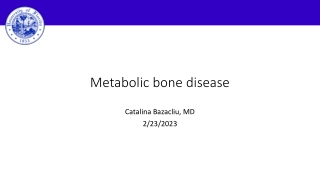



![(❤Read⚡) [✔PDF✔] Noodles for Baby](/thumb/68039/read-pdf-noodles-for-baby-powerpoint-ppt-presentation.jpg)

